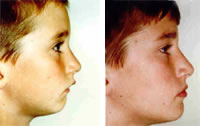The attractiveness of a child’s face depends largely on two things:
• The shape of their parents faces
• Whether their face grows forwards or downwards.
While the first is fixed at conception, the second displays a range between ‘horizontal’ which orthodontists label favourable and ‘vertical’ which is considered unfavourable. Horizontal growth is associated with good looks, square jaws and straight teeth, while vertical growth produces the reverse, and the effects of this may range from the barely perceptible to the markedly unattractive. The direction of growth can be affected by a range of simple things like thumb sucking or hanging the mouth open, both of which encourage ‘vertical’ growth and the degree of damage will depend on the severity of the habit.
Orthodontics Damage.
The public have a strong preference for ‘horizontally’ growing faces. Unfortunately there is clear evidence that almost any kind of orthodontic treatment encourages an increase in the unattractive ‘vertical’ growth (Battagel 1996).
It is interesting to note that orthodontists seem to prefer the flatter profiles seen with ‘vertically’ growing faces. (Peck and Peck)
Recent evidence (Clark et al 1998) would suggest that the large majority of orthodontists in Britain are not interested in the relationship between oral habits and the direction of facial growth. Furthermore that 91% are prepared to extract teeth, even if there is no crowding and 63% to pull teeth back despite strong evidence to show that this encourages ‘vertical’ growth. Not only is this approach likely to damage facial appearance but the teeth often re-crowd after treatment despite the extractions.


(Above picture- Same girl before and after treatment). (Above picture- the result of ‘forward’ growth).